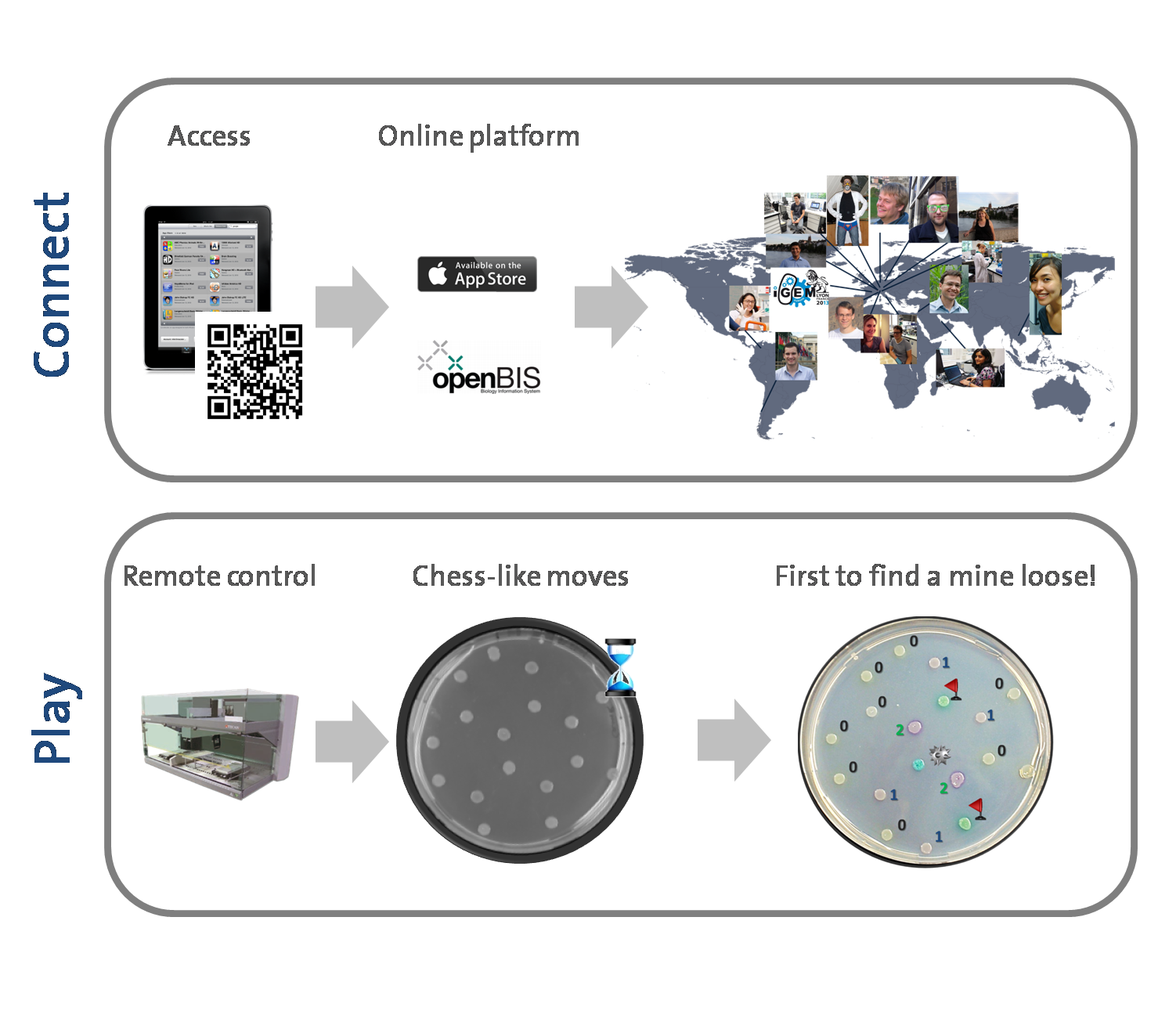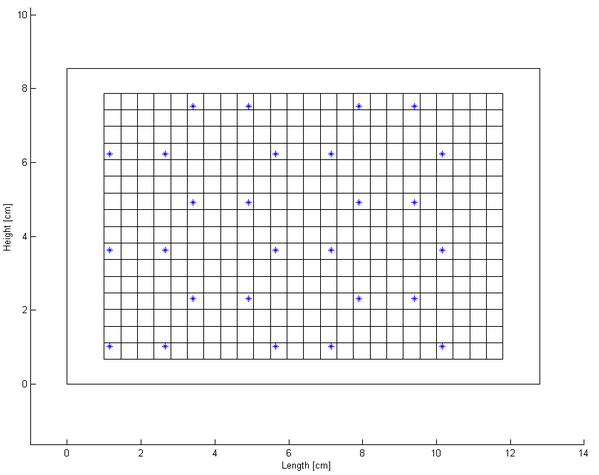Team:ETH Zurich/World
From 2013.igem.org
| (9 intermediate revisions not shown) | |||
| Line 3: | Line 3: | ||
<h1>Colisweeper as a worldwide interaction platform</h1> | <h1>Colisweeper as a worldwide interaction platform</h1> | ||
| + | <p align="justify">We believe that Colisweeper is an original and novel tool that can be employed to <b>raise awareness and educate people about synthetic biology</b>. We envision an application with which people from all over the globe can remotely interact to participate in a <b>multi-player game</b> (Figure 1). For this no scientific background is necessary, which is one of the most important characteristics of the [https://2013.igem.org/Team:ETH_Zurich/Human gamification concept]. Using a <b>global web-based platform</b>, accessible via a smart phone application that can be downloaded, people can remotely connect with other people miles away. At the department of Biosystems Science and Engineering, ETH-Zurich in Basel, we have a platform called [http://www.cisd.ethz.ch/software/openBIS openBIS]. OpenBIS is an Open Source Biology Information System whose purpose is the management, annotation and sharing of data measured in biological experiments. We plan to create a <b>QR Code</b> to access our website and application for smartphones and tablets to connect to the <b>openBIS platform</b>. Using OpenBIS, global players can connect to a cloning robot at our department via remote control. Once connection is established, our bio-game Colisweeper can be played with multiple players across the world. The game grid can be viewed by the players with each position of the colony in the grid represented by an alpha-numeric code. In order to teach the robot where to pipette we need a map of the honeycomb pattern on a <b>386well plate</b>, which the robot is used to see (Figure 2). With this little trick we can tell the robot exactly where to pipette on the agar plate. The player chooses a code and controls the robot that makes the actual move. Alternatively, the opponent player makes a move. The player that encounters the mine colony first loses the game. We <b>successfully demonstrated the remote control of the robot handling one of our Colisweeper plates</b>, below you can '''find a video''' of the robot in action.<br> | ||
| + | This web-based access to the laboratory robot offers huge possibilities not only for individuals, but also for big events and presentations since the camera records can be presented on any scale. To achieve a functioning system though we would still have do accomplish a lot of work. During our planning a lot of questions regarding safety of the access, coordination of the robot and handling of the plates came up. So we consider this plan more as a priming idea for others to catch on to, take part and develop it further into all kinds of applications, ranging from entertainment to education and even marketing or instruction.<br></p> | ||
| + | [[File:Worldmap1.jpg|500px|left|thumb|<b>Figure 1: A schematic diagram of a global, web-based platform to play Colisweeper </b>]] | ||
| + | [[File:GridV2.png|right|520px|thumb|<b>Figure 2: 386 well plate training of the roboter.</b> Mapping of the honeycomb pattern onto a 386well plate allows us to tell the robot exactly where to pipette on the agar plate.]] | ||
| - | |||
<br clear="all"/> | <br clear="all"/> | ||
| - | |||
| - | |||
{{:Team:ETH Zurich/Templates/Video| | {{:Team:ETH Zurich/Templates/Video| | ||
width=660px| | width=660px| | ||
| Line 13: | Line 14: | ||
ratio=143/100| | ratio=143/100| | ||
srcMP4=<html>https://static.igem.org/mediawiki/2013/e/eb/HumanpracticevideoConverted.mp4</html>}}<br><br> | srcMP4=<html>https://static.igem.org/mediawiki/2013/e/eb/HumanpracticevideoConverted.mp4</html>}}<br><br> | ||
| - | |||
| - | |||
| - | |||
<br clear="all"/> | <br clear="all"/> | ||
{{:Team:ETH_Zurich/templates/footer}} | {{:Team:ETH_Zurich/templates/footer}} | ||
Latest revision as of 21:46, 28 October 2013
Colisweeper as a worldwide interaction platform
We believe that Colisweeper is an original and novel tool that can be employed to raise awareness and educate people about synthetic biology. We envision an application with which people from all over the globe can remotely interact to participate in a multi-player game (Figure 1). For this no scientific background is necessary, which is one of the most important characteristics of the gamification concept. Using a global web-based platform, accessible via a smart phone application that can be downloaded, people can remotely connect with other people miles away. At the department of Biosystems Science and Engineering, ETH-Zurich in Basel, we have a platform called [http://www.cisd.ethz.ch/software/openBIS openBIS]. OpenBIS is an Open Source Biology Information System whose purpose is the management, annotation and sharing of data measured in biological experiments. We plan to create a QR Code to access our website and application for smartphones and tablets to connect to the openBIS platform. Using OpenBIS, global players can connect to a cloning robot at our department via remote control. Once connection is established, our bio-game Colisweeper can be played with multiple players across the world. The game grid can be viewed by the players with each position of the colony in the grid represented by an alpha-numeric code. In order to teach the robot where to pipette we need a map of the honeycomb pattern on a 386well plate, which the robot is used to see (Figure 2). With this little trick we can tell the robot exactly where to pipette on the agar plate. The player chooses a code and controls the robot that makes the actual move. Alternatively, the opponent player makes a move. The player that encounters the mine colony first loses the game. We successfully demonstrated the remote control of the robot handling one of our Colisweeper plates, below you can find a video of the robot in action.
This web-based access to the laboratory robot offers huge possibilities not only for individuals, but also for big events and presentations since the camera records can be presented on any scale. To achieve a functioning system though we would still have do accomplish a lot of work. During our planning a lot of questions regarding safety of the access, coordination of the robot and handling of the plates came up. So we consider this plan more as a priming idea for others to catch on to, take part and develop it further into all kinds of applications, ranging from entertainment to education and even marketing or instruction.
 "
"







